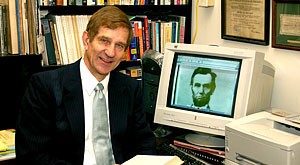
UC History Professor Offers Expertise as U.S. Mint Makes Change in Lincoln Penny
University of Cincinnati history professor John K. Alexander's most high-profile side gig is unpaid. From a historical standpoint, however, it's right on the money.
Since 2005, Alexander has been the resident United States historian for the U.S. Mint's Citizens Coinage Advisory Committee, a group established in 2003 to advise the Secretary of the Treasury on theme and design proposals for coinage and other Mint-made products.
The 11-member CCAC's most recent charge? Making recommendations for the redesign of the "tails" side of the Lincoln penny, to coincide with the 200th anniversary of Abraham Lincoln's 1809 birth and the 100th anniversary of the 1909 introduction of the Lincoln coin.
The redesign, recently covered by the Associated Press in a story quoting Alexander, is sparking a national buzz. But amidst constant rumors of the 1-cent coins disappearing due to the high cost of making them, Alexander thinks you can take this to the bank: As long as pennies are around, the famous profile of the 16th U.S. president will most likely adorn the "heads" side of them.
"It's fair to say the penny is one of the most beloved of American coins," says Alexander, a distinguished teaching professor who came to UC in 1969. "In part, that's because it's such a striking portrait of Lincoln and I think that's why we're not likely to see that image disappear."
As mandated by U.S. law, a United States historian must be on the committee. That's practically "found money" for a guy like Alexander, a former coin collector and American history expert who's a stickler for accuracy on items depicting historical events.
Alexander, who earned his PhD at the University of Chicago, is quick to clear up misconceptions about his position and the committee's work. The CCAC, for example, does not "decide" what will go on a coin it only assesses and recommends based on what comes before it. He adds that "Congress must authorize doing any coins and can give general directions, but the final design decision assuming the law or laws are followed, of course is in the hands of the director of the U.S. Mint."
His enjoyment for the task at hand is due, too, in no small part to the diversity of the committee, set to meet 10 times in 2007. His colleagues include an expert trained in numismatics, a public interest expert and an artist familiar with the "coinability" of designs considered for die-struck items.
"I just love being on this committee," says Alexander who laughingly admits he'll still pick up a penny he spots on the street. "People listen to each other. Minds have been changed
We can only recommend, but we can perhaps have an influence on coins that will be here forever."
Related Stories
UC Honors students gain hands-on research experience
April 1, 2025
The Biomedical Research and Mentoring Program is open to any University Honors Program students. The faculty mentors are typically from UC’s College of Medicine or Cincinnati Children's Hospital.
Exploring careers in robotics engineering: A path to the future
March 28, 2025
Discover robotics engineering careers: skills, paths, and opportunities in manufacturing, healthcare, and space. Explore salaries and how to start at UC’s CEAS.
President Pinto shares search update for executive vice...
March 25, 2025
President Neville Pinto shares search update for executive vice president for academic affairs and provost
